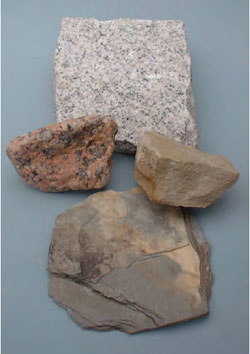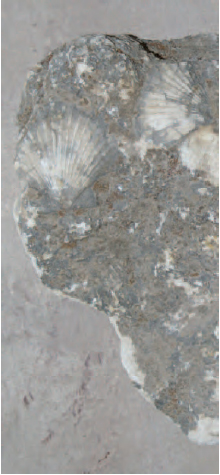Formation of soils
ContentThe Earth formed from a ball of molten rock minerals. The least dense rocks floated on the top and as they cooled the surface layer of granite, with basalt just below, solidified to form the Earth’s crust. The Earth’s surface has had a long and turbulent history during which it has frequently fractured, crumpled, lifted and fallen, with more molten material being pushed up from below through the breaks in the crust and in volcanoes. Weathering From the moment that rocks are exposed to the atmosphere, they are subject to weathering. This breakdown of the rocks is brought about by the effect of chemical, physical and biological factors. Chemical weathering is mainly brought about by the action of carbonic acid that is produced wherever carbon dioxide and water mix, as in rainfall. Some rock minerals dissolve and are washed away. Others are altered by various chemical reactions, most of which occur when the rock surface is exposed to the atmosphere. All but the inert parts of rock are eventually decomposed and the rock crumbles as new minerals are formed and soluble material is released. Oxidation is particularly important in the formation of iron oxides, which give soils their red and yellow (when aerobic), or blue and grey colours (in anaerobic conditions). Physical or mechanical weathering processes break the rock into smaller and smaller particles without any change in the chemical character of the minerals. This occurs on exposed rock surfaces along with chemical weathering but, in contrast, has little effect on rocks protected by layers of soil. The main agents of physical weathering are frost, heat, water, wind and ice. In temperate zones, frost is a major weathering agent. Water percolates into cracks in the rock and expands on freezing. The pressures created shatter the rock and, as the water melts, a new surface is exposed to weathering. In hot climates the rock surface can become very much hotter than the underlying layers. The strains created by the different amounts of expansion and the alternate expansion and contraction cause fragments of rock to flake off the surface; this is sometimes known as the ‘onion skin’ effect. Moving water or wind carries fragments of rock that rub against other rocks and rock fragments, wearing them down. Where there are glaciers the rock is worn away by the ‘scrubbing brush’ effect of a huge mass of ice loaded with stones and boulders bearing down on the underlying rock. Biological weathering is attributable to organisms such as mosses, ferns and flowering plants which fragment rock by both chemical and physical means, e.g. they produce carbon dioxide which, in conjunction with water, forms carbonic acid; roots penetrate cracks in the rock and, as they grow thicker, they exert pressure which further opens up the cracks.
Rocks Igneous rocks are those formed from the molten material of the Earth’s crust. All other rock types, as well as soil, are ultimately derived from them. When examined closely, most igneous rocks can be seen to be a mixture of crystals. Granite is one of the commonest and contains crystals of quartz, white and shiny, felspars that are grey or pink, and micas, which are shiny black (see Figure 17.3). Many of these crystalline materials have a limited use in landscaping as formal structures rather than in the construction of rock gardens; more commonly they are used in monuments and building facades. As granite is weathered (‘rotted’) the felspars are converted to kaolinite (one of the many forms of clay) and soluble potassium, a plant nutrient. Similarly, the mica present is chemically changed to form clay and yield soluble minerals. Whilst the many types of clay retain much of the potassium, sodium, calcium, etc., the soluble material is carried by water to the sea making the sea ‘salty’. The inert quartz grains are released and form sand grains. Sedimentary rock is derived from accumulated fragments of rock. Most have been formed in the sea or lakes to which agents of erosion carry weathered rock. Organisms in the seas with shells die and accumulate on the bottom of the sea. Layers of sediment build up and, under pressure and slow chemical change, eventually become rock strata such as shale, chalk or limestone. In subsequent earth movements much of it has been raised up above sea level and weathered again. Similarly, the sand grains that accumulate to great depths in desert areas eventually become sandstones (Figure 17.3).
The type of sedimentary rock formed depends on the nature of its ingredients. Sandstones, siltstones and mudstones are examples of sedimentary rocks derived from sorted particles in which characteristic layers are readily seen. Limestones are formed from the accumulation of shells (see Figure 17.4) or the precipitation of materials from solution mixed with varying amounts of deposited mud. Chalk is a particularly pure form derived from the calcium carbonate remains of minute organisms that lived in seas in former times. Many of these are attractive materials for use in hard landscaping, where care should be taken to align the strata (layers) for a natural effect. Metamorphic rock is formed from igneous or sedimentary rocks. The extreme pressures and temperatures associated with movements and fracturing in the Earth’s crust or the effect of huge depths of rock on underlying strata over very long periods of time has altered them. Slate is formed from shale, quartzite from sandstone, and marble from limestone. Metamorphic rock tends to be more resistant to weathering than the original rock. |






